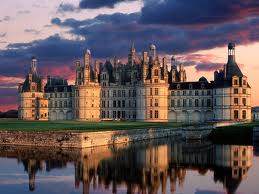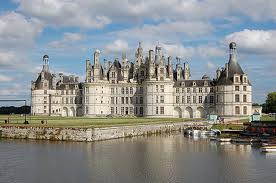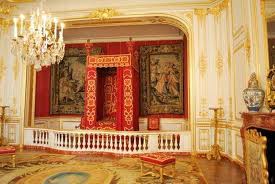The Château de Chambord was actually used as the inspiration for the Beast’s castle in the 1991 animated Disney film Beauty and the Beast.
Do you need more incentives to visit?
If that is not enough, it is also one of the most recognizable châteaux in the world, not because of Disney, but because of its very distinct French Renaissance architecture.
Like all the best châteaux in the Loire Valley, the Château de Chambord has an interesting and intriguing history.

To get a grasp of this grandiose château we have to go back to the King who had it built. We are talking about no other than Francis I who at 25 was young and one of the most powerful men in Europe and he wanted to show the world what he was about. He combined his two passions, architecture and hunting.
And boy did he do it.
Chambord, surrounded by a dense forest packed with game, is quite frankly the stuff of fantasy. As you travel down the tree-lined roads towards the château you will first glimpse the incredible towers that should belong to an entire cityscape, not just a single building.
It is thought that the legendary Leonardo da Vinci was potentially the driving force behind the whole project although he died before construction was started.
In the second half of 1519 (6 September) the order came from François I that construction was to begin on the Château de Chambord. No one can agree on who was responsible for the design of the château: some say it was the French Renaissance architect Philibert Delorme while in the 20th century a theory says that Leonardo da Vinci might have been the designer or at least involved with some of it as he was interested in central planning and double helical staircase (more to come on that later).
Built on the site of an ancient castle, Chambord was supposed to be a mere hunting lodge. Rumor has it that the King may have chosen this location in part to be near his mistress Comtesse de Thoury whose domain, the château de Muides, was adjacent. Whether this is true or not is part of the myth, however her arms are carved in the château.
The work on the château was interrupted between 1521 and 1526 as the the Four Years War, part of the Italian Wars took place, and then it was further slowed as the arcs of the royal treasury were greatly affected. There were also some difficulties when it was time to set the foundations of the castle.
In 1524 the walls of the château had barely been raised. In 1526 some 1,800 workers were employed to restart the construction of Château Chambord.

At the time of his death in 1547 François I had only spent 7 weeks at Château de Chambord; however to take all his luggage, retinue and servants 12,000 horses employed.
Despite its beauty the château was impractical to live in on a long-term basis -it had massive rooms, open windows and incredibly high ceilings. All of this meant it was cold and hard to heat and to make things worse there were no immediate town or villages in its proximity, so there was no real source of food close enough to Château de Chambord.
After the death of the king, the castle was abandoned by the French kings for over 80 years but in 1629 King Louis XIII deemed it worthy of his brother Gaston d'Orléans. Exiled twice to the country by Louis, he spent a lot of time at Château de Chambord and started restoration work to revive the dilapidated château.
It wasn't finished until the reign of Louis XIV who liked the estate very much and added a 1,200 horse stable to the property.
The 18th century brought with it lots of guests and residents for Chambord the first of which was Stanislas Leszczynski, the deposed King of Poland and King Louis XV's father-in-law. Fleeing from his own country, Leszczynski lived at Chambord from 1725 to 1733.
In 1748 Chambord was awarded to Maurice de Saxe for military victories and his nephew took over residence after his death. Finally the sprawling château was furnished and full of life.
During the Revolution the Château de Chambord was pillaged for all it was worth, all the furniture, wall paneling and even the floors were taken up and sold.
It was also used as a powder manufacturing workshop, a prison and the headquarters of the 15th cohort of the Legion of Honor. In 1809 Napoleon Bonaparte gave it to Marshal Berthier who spent a total of two days there.
The château was purchased from his widow for the Duke of Bordeaux, who was less than a year old at the time and took the title of Comte de Chambord. The young royal was exiled in 1830 after a brief attempt at restoration was made by his grandfather King Charles X.
The château lay untouched for years.
Used briefly as a field hospital during the Franco-Prussian war (1870-71), it fell into disrepair.
Just before his death the Comte de Chambord attempted some restoration but when he died in 1883 the estate was given to his sister's heirs, the Ducal family of Parma. Any attempts to restore the once magnificent château ended with the outbreak of the First World War.
Château de Chambord was confiscated as enemy property in 1915 but the Duke of Parma sued to recover it in a lengthy court case that wasn't settled until 1932 (when the state took control of the estate).
Shortly before the outbreak of the Second World War, the art collections of the Louvre and Compiègne museums (even including the Mona Lisa and Venus de Milo) were taken from Paris and hidden from the Nazis in Chambord.
The château has been in state hands ever since 1932 and is now a major tourist attraction.

The château is enormous with about 400 rooms, over 80 staircases, 365 staircases and a great number of towers, domes and pinnacles. The incredible extravagance of the roof can be explained by François I's desire to recreate the skyline of Constantinople.
Don't forget to look out for the architectural highlight of the château : the spectacular double-helix open staircase. Illuminated from above by a sort of light house at the highest point of the château, it look likes a single staircase but the two spirals never meet.
There are suggestions that Leonardo da Vinci may have designed the staircase (he had a thing about spirals), but this has not been confirmed.
Chambord is accessible in an hour and a half from Paris - take the train from Paris Austerlitz and get off at Blois or Mer station. From Blois a shuttle bus runs to the château from May to September. If you are getting to Chambord by car then leave the A10 motorway at junction 16 (for Mer) or 17 (for Blois).
The calendar is packed with activities going on at Chambord throughout the year. From light shows and tours of the park in a 4x4 vehicle to classical music concerts and guided tours on bike or horseback there is something to suit everyone. Check out the web site for more information on what's happening.